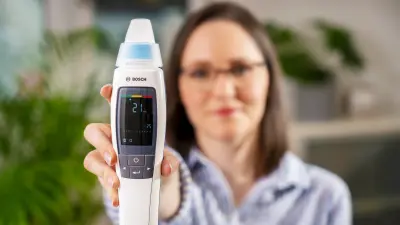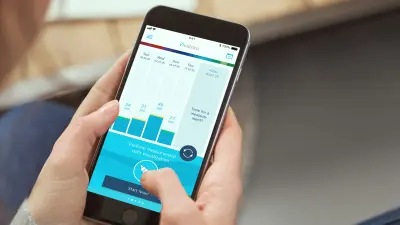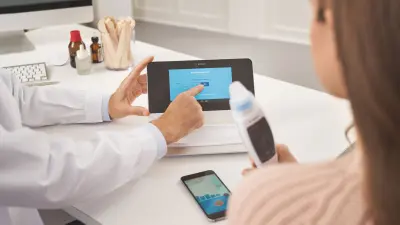Is your asthma under control?
One in three sufferers does not have their asthma fully under control. In children, more than half are not sufficiently controlled. However, there are modern diagnostic and therapeutic options that can completely suppress even severe forms of asthma.

Can asthma actually be cured?
Complete remission is possible, but many sufferers do not receive optimal therapy
Asthma is a common disease with around 262 million people affected worldwide. Symptoms range from coughing and wheezing to shortness of breath and attacks of suffocation that end in hospitalization. Around 40% of those affected do not have complete control over their asthma, and more than 1,000 people die every day as a result.1 Even people with less severe asthma often accept restrictions in their everyday lives – usually unconsciously, because they have already got used to them (coping). From a medical point of view, this is not necessary: Modern medication can suppress even severe forms of asthma to such an extent that sufferers no longer feel any symptoms or deterioration (complete remission).4 More and more experts are therefore calling for a radical rethink in asthma management: away from treating acute symptoms. Towards prevention with individual precision therapy. Find out how this works here.

How Lina (13) got her asthma under control

Loading the video requires your consent. If you agree by clicking on the Play icon, the video will load and data will be transmitted to Google as well as information will be accessed and stored by Google on your device. Google may be able to link these data or information with existing data.
Find out how Lina B. (13) got her asthma under control with the help of FeNO home monitoring.
How does modern asthma management work?
"If you can’t measure it, you can’t manage it." (Peter Drucker)
Roughly simplified, asthma management works like this: The doctor makes a diagnosis and prescribes medication if necessary. The patient comes to the practice for regular check-ups. If everything looks good, the medication is maintained. If not, the doctor changes the therapy depending on the results of the examination.4 He usually asks the patient about their medical history, identifies symptoms and carries out a lung function test.The test shows how powerful the lungs are and how much the airways are constricted. What is relatively new are biomarkers such as eosinophils and Fractional exhaled Nitric Oxide (FeNO) in the breath. They show how inflamed the airways are. This information is important for the doctor when prescribing anti-inflammatory medication such as biologics or inhaled corticosteroids (ICS). Using these inflammation markers, he can recognize whether they are working.
A challenge in asthma management is mostly the infrequent visits to the doctor's practice: When patients come for a check-up a few times a year, the doctor takes a snapshot of their current condition. He cannot measure how the asthma develops between check-ups. As a result, patients are sometimes not detected during the practice measurement, even though there is an urgent need for action. This is impressively illustrated by a case study from the new FeNO@home study, which is expected to be published in September 2024. Although the patient reported severe symptoms, his values were normal when he visited the doctor. Only after measuring FeNO values at home did it become apparent that he had repeatedly and massively exceeded the official inflammation thresholds2. This caused the doctor to prescribe him a modern biologic.3 Conversely, patients may regularly take too much or the wrong medication because they had a "bad day" when they went for their check-up, for example due to an acute infection.
FeNO home measurement can help here: If patients regularly measure and document their FeNO value at home, they know exactly how their inflammation is progressing. This allows them to adjust their therapy to their actual needs at any time in consultation with their doctor. The FeNO progression over a longer period of time helps those involved to better understand the individual development of the disease and to initiate the right measures at an early stage, if necessary even before the next check-up appointment. This is particularly important when it comes to selecting the right medication and the appropriate dosage – not too much and not too little.3

Asthma expert explains the benefits of FeNO

Loading the video requires your consent. If you agree by clicking on the Play icon, the video will load and data will be transmitted to Google as well as information will be accessed and stored by Google on your device. Google may be able to link these data or information with existing data.
Prof. Dr. med. Felix Herth is Medical Director of the Thorax Clinic and Head Physician at Heidelberg University Hospital.
What is FeNO?
Asthma is an inflammation of the airways that causes the mucosa to produce nitric oxide. This can be measured as Fractional exhaled Nitric Oxide (FeNO). The higher the value, the greater the inflammation. The inflammation marker FeNO is considered an indispensable part of specialist diagnostics.4

FeNO
FeNO measurement is quick and does not hurt. Vivatmo me from Bosch is the world's only system for home use. The FeNO biomarker has many advantages:1-10
- Objective: Internationally standardized measurement method with reference values for an understandable traffic light system.
- Preventive: Indicates deterioration earlier than the peak flow method – even before symptoms are noticeable.
- Holistic: Regular measurements provide a comprehensive picture of the inflammatory process and can reveal the influence of medications, allergens, and other triggers.
New: FeNO value can also be measured at home
Until now, asthmatics have been able to take measurements at home using spirometers or peak flow devices. But these devices only check how restricted the airways are. They measure the consequences of asthma, not the causes. FeNO measurement starts much earlier: with the current inflammatory state of the bronchial tubes. If FeNO values are irregular, people with asthma can talk to their doctor to initiate immediate action – ideally before they notice any symptoms. Until now, FeNO devices could only be used by trained specialists. But now Bosch has developed the Vivatmo me, the first FeNO monitoring device for home use. It allows asthmatics to take their own measurements at any time – quickly, easily, and non-invasively.

How Bosch FeNO measurement works

Loading the video requires your consent. If you agree by clicking on the Play icon, the video will load and data will be transmitted to Google as well as information will be accessed and stored by Google on your device. Google may be able to link these data or information with existing data.
Vivatmo me is the world’s first and only FeNO measuring device for home use. Watch the clip to learn more about Bosch’s high-precision Senso technology.
Sources:
1 The Global Asthma Report. Int J Tuberc Lung Dis 2022; 26: 24, 30
2 American Thoracic Society (ATS) Guideline: Interpretation of Exhaled Nitric Oxide Levels (FeNO) for Clinical Applications, Dweik et al. Am J Respir Crit Care Med 2011;184:602-15
3 Cf. Case Reports 1-5 from the FeNO@home Study 2023/2024.
4 Deutsche Gesellschaft für Pneumologie und Beatmungsmedizin e.V. (Hrsg.) 2023 S2k-Leitlinie zur fachärztlichen Diagnostik und Therapie von Asthma 2023: 6, 47, 53ff.
5 Nationale VersorgungsLeitlinie (NVL) Asthma: www.leitlinien.de/nvl/asthma
Karrasch et al. Thorax 2017;72:109-16
6 Taylor et al. Thorax 2006;61:817-27
7 Petsky et al. Cochrane Database of Systematic Reviews 2016;9: CD011440
8 Essat et al. Eur Respir J 2016;47:751-68
9 ATS/ERS Am J Respir Crit Care Med 2005;171:912-30
10 Horváth et al. Eur Respir J 2017;49:1600965









